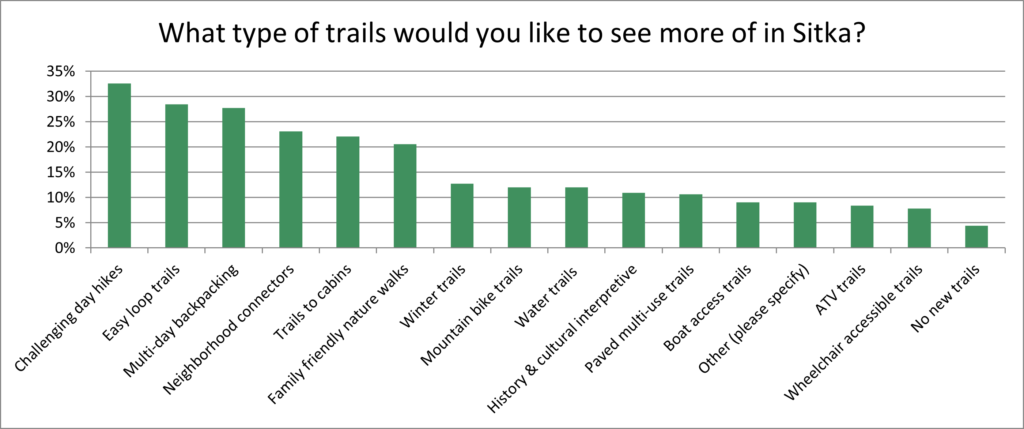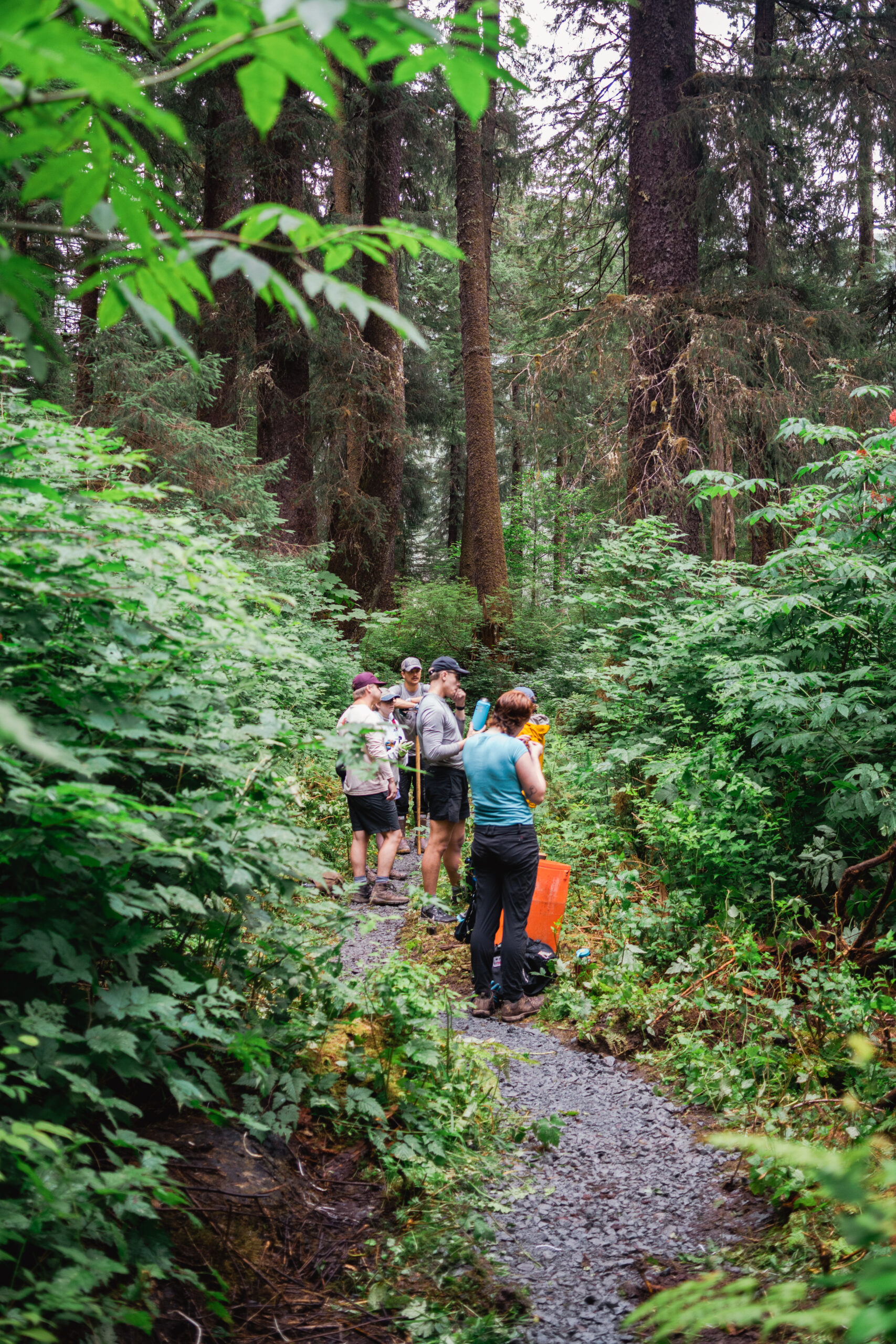SITKA TRAIL WORKS PRESS RELEASE
Thursday, June 16th, 2022
As part of a community-wide planning process, Sitka Trail Works ran a public survey to solicit feedback on the future of our trail system during the months of April and May. Over 10{abf465c19454c250f574557adc626a2e06d1cd01c0781f16298455748ce24614} of Sitka’s adult population, a total of 787 people, took the survey, showing an immense interest in planning the future of our shared recreation infrastructure.
Sitka Trail Works designed the survey with the input of public land managers and a citizen advisory board, deploying an opportunity sampling methodology to make the survey open to all Sitkans. While wide distribution facilitated large response rates, the data does not constitute a random sample that is statistically representative of the general Sitka population.
Survey data reveals Sitkans desire for trails
The results are clear: Sitkans cherish our trail system. Over 40{abf465c19454c250f574557adc626a2e06d1cd01c0781f16298455748ce24614} of respondents say they use trails several times a week and 94{abf465c19454c250f574557adc626a2e06d1cd01c0781f16298455748ce24614} reported using the trails at least several times a year. While these percentages can’t be directly extrapolated to represent all of Sitka, the absolute values, over 700 regular trail users in the sample, suggest Sitkans are far more active trail users than most of their fellow Americans.
The Cross Trail stood out as the most popular facility, with hundreds of Sitkans reporting almost daily use.
While weather, time, and bear safety were reported as top barriers to using the trails more often, over 100 respondents cited a lack of a hiking buddy as an impediment. Sitka Trail Works offers free group hikes on summer weekends for those looking for trail companions. The threat of bear encounters was far and away the greatest concern reported by respondents. A distant second concern was the prevalence of misbehaved dogs off leash, which 155 respondents cited as a higher concern than hazardous trail conditions, remoteness, getting lost, or other barriers.
Seventy five percent of respondents reported bike or walking to work, school, or errands at least once or twice a year. Weather was the most commonly reported barrier to traveling by bicycle more often, with concerns for potential vehicle collisions as the second-most reported barrier, suggesting a need for more and safer bicycle infrastructure.
The Mosquito Cove Trail was cited as the most in need of maintenance. In response, Sitka Trail Works hosted a volunteer maintenance day and addressed a stretch of eroded and muddy tread, with support from Alaska State Parks, who manages the trail.
When asked about the relative importance of maintaining existing trails versus developing new trails, Sitkans struck an even balance, requesting a split investment between expansion and maintenance. This feedback illustrates the community’s pragmatism, while desiring some expansion to meet demand for improved access to our spectacular outdoors.
To determine future development priorities, the survey provided a list of types of trails for respondents to select as their top choices.

Challenging day hikes, easy loop trails, and multi-day backpacking trails were the most common top choices, with neighborhood connector trails and trails to public use cabins close behind. Less frequent trail users (n=131 respondents who use trails less than once a month) stated a top preference for easy loop trails, followed by family friendly nature walks, and pathways between neighborhoods and downtown, suggesting that easier, more accessible facilities could attract more Sitkans to participate in active lifestyles. Less frequent trail users also reported a desire for more benches along trails.
Of all respondents, trailhead signage, cabins, and benches were mostly commonly requested trail amenities, in that order.
Disaggregating the data to understand the preferences of subsistence harvesters (n=97 respondents who indicated subsistence harvesting as one of top 2 reasons for using trails) revealed that the vast majority (87{abf465c19454c250f574557adc626a2e06d1cd01c0781f16298455748ce24614}) use trails to access hunting, foraging, or fishing. This data illustrates that our trail system does more than facilitate healthy exercise, it helps Sitkans put food on the table. For amenities to improve outdoor access, harvesters requested more cabins and shelters.
Over half of the survey takers elected to answer additional questions about cabins and water trails. The strong majority of respondents, almost 300 Sitkans, think that Sitka would benefit from water trails, designated routes that identify safe shoreline access with overnight opportunities. Similarly, over 300 people (80{abf465c19454c250f574557adc626a2e06d1cd01c0781f16298455748ce24614} of respondents) report a lack of availability when trying to reserve a public use cabin. Respondents ranked walk or bike in cabins as most desirable, with boat access cabins as a second priority.
Next steps for trail planning
Sitka Trail Works, with oversight by a citizen advisory committee, will take trends from the survey results, along with feedback received at an open house and public meetings with various community groups, and begin to develop initial trail concepts that address stated demand. The summer field season will be used to assess potential routes that align with community desires.
Sitka Trail Works is meeting regularly with public agency partners including the City of Sitka, State Parks, the Forest Service, and the National Park Service, to ensure the plans recommendations are grounded in land managers perspectives.
A focus on maintenance of existing trails will be an essential component of the future plan and Sitka Trail Works is conducting analysis to further that cause.
Once initial trail concepts are developed, Sitka Trail Works will bring a draft plan back to the community for another round of public input. Only after thorough vetting to ground the focus in community priorities will Trail Works publish a new plan to shape the future of our trails for the next twenty years.

